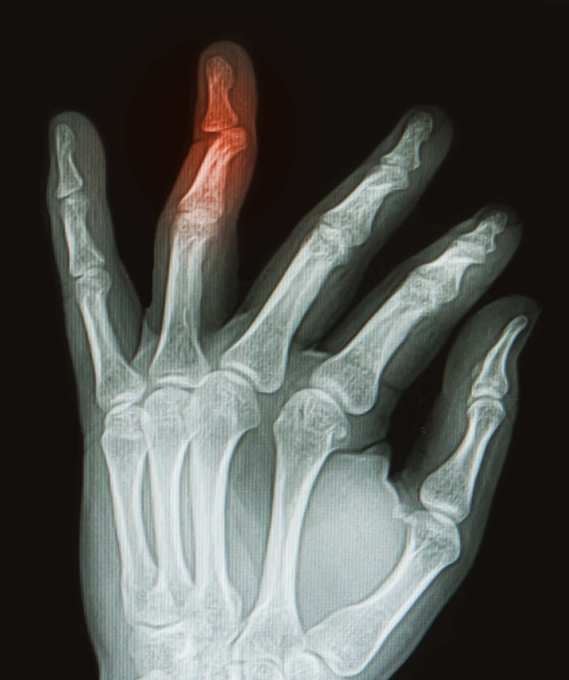Jan 8 2019
Researchers at Imperial College London have produced a new bioinspired material that interacts with neighboring tissues to drive healing.
 TrAPs could harness the body’s natural healing powers to repair bone. (Image credit: Imperial College London)
TrAPs could harness the body’s natural healing powers to repair bone. (Image credit: Imperial College London)
Materials are extensively used to assist in the healing of wounds: Scaffold-like implants are used to repair fractured bones and collagen sponges help treat pressure sores and burns. Yet, the tissue repair process varies over time; therefore, researchers are turning toward biomaterials that interact with tissues as healing occurs.
At present, Dr Ben Almquist and his colleagues at Imperial College London have produced a new molecule that could transform the way conventional materials work with the body. Their method, called traction force-activated payloads (TrAPs), allows materials to interact with the body’s natural repair systems to promote healing.
According to the researchers, integrating TrAPs into current medical materials could transform the way injuries are treated.
Our technology could help launch a new generation of materials that actively work with tissues to drive healing.
Dr Ben Almquist, Department of Bioengineering, Imperial College London
The outcomes of the study have been reported in Advanced Materials.
Cellular Call to Action
Following an injury, cells “crawl” through the collagen “scaffolds” that exist in wounds, similar to spiders finding the way to webs. While moving, these cells pull on the scaffold, thereby triggering hidden healing proteins that start to repair injured tissue.
The study researchers developed TrAPs as a means to recreate this natural healing process. DNA segments were folded into three-dimensional shapes called aptamers that adhere firmly to proteins. After that, a customizable “handle” that can be held by cells was attached onto one end, before the opposite end was attached to a scaffold such as collagen.
When they performed laboratory testing of their technique, the researchers found that cells pulled on the TrAPs as they crawled through the collagen scaffolds. The pulling caused the TrAPs unknot like shoelaces to expose and stimulate the healing proteins. These proteins command the healing cells to grow and multiply.
Furthermore, the scientists found that by altering the cellular “handle”, it is possible to change which type of cell can grab hold and pull, allowing them to customize TrAPs to release specific therapeutic proteins depending on the type of cells present at a given point in time. By doing this, the TrAPs produce materials that can cleverly interact with the right type of cell at the right time during wound repair.
For the first time, scientists have activated healing proteins using different cell types in man-made materials. The approach mimics the natural healing methods.
Creatures from sea sponges to humans use cell movement to activate healing. Our approach mimics this by using the different cell varieties in wounds to drive healing.
Dr Ben Almquist, Department of Bioengineering, Imperial College London
From Lab to Humans
As this technique is adaptable to different cell types, it can be employed in a range of injuries such as scar tissue after heart attacks, fractured bones, and damaged nerves. In addition, new techniques are very much needed for patients whose wounds won’t heal even with current interventions, for example, diabetic foot ulcers, which are the foremost cause of non-traumatic lower leg amputations.
TrAPs are comparatively simple to create and are completely man-made, implying that they can be easily recreated in various labs and can be scaled up to industrial quantities. Their adaptability also implies that they could help researchers develop innovative techniques for laboratory studies of stem cells, diseases, and tissue development.
Aptamers are presently used as drugs, which means they are already proven safe and optimized for clinical use. Since TrAPs make use of aptamers that are safe for humans, it may be possible for them to take a shorter path to the clinic when compared to methods that start from scratch.
TrAPs provide a flexible method of actively communicating with wounds, as well as key instructions when and where they are needed. This intelligent healing is useful during every phase of the healing process, has the potential to increase the body’s chance to recover, and has far-reaching uses on many different types of wounds. This technology could serve as a conductor of wound repair, orchestrating different cells over time to work together to heal damaged tissues.
Dr Ben Almquist, Department of Bioengineering, Imperial College London
The study was funded by the Engineering and Physical Sciences Research Council and the Wellcome Trust.
TrAPs: DNA Nanotechnology for Wound Healing
Video credit: Imperial College London